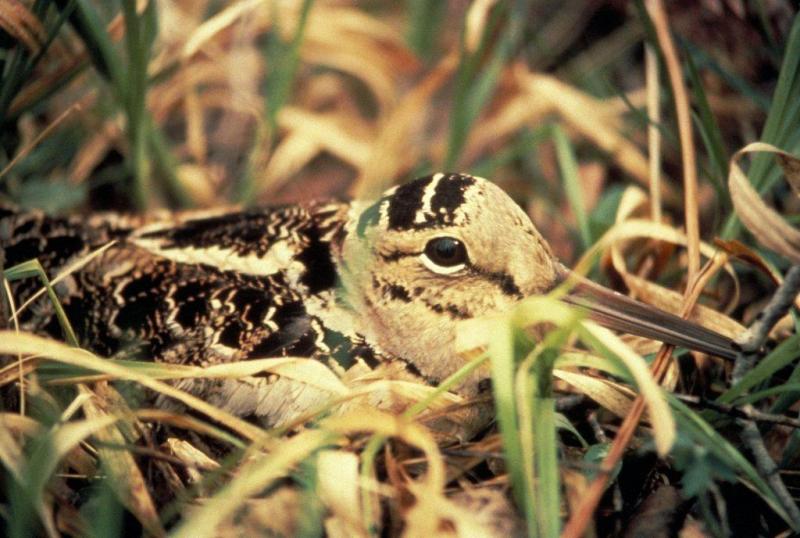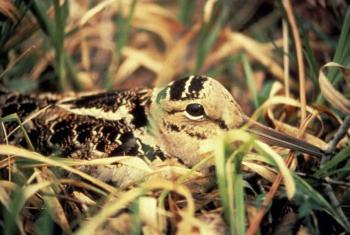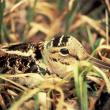The beep-beep bird
Beginning sometimes in mid-March, just as evening darkness begins to settle over fields and thickets, listen for it: a strange, low, repeated nasal bleeting call.
The uninitiated sometimes mistake the sound to be a frog. But the real vocalist is more surprising: a hormone-flooded bird the size of a large grapefruit with what seems like a way-too-long bill, short little legs, and big eyes.
It’s the American woodcock, a member of the shorebird family. Cousin to sandpipers and yellowlegs but with many amazing twists to its behavior and life history.
For example, rather than feeding along the “shore” in mudflats and tidal pools, as you might expect a shorebird to do, the American woodcock unobtrusively stays in alder thickets and at the edges of fields where it probes the moist ground with its long bill in search of worms and other soil-dwelling invertebrates.
Its bill is unusually sensitive, allowing the bird to feel the movement of its prey with the bill tip and flex it open to seize it and extract it from the ground.
American woodcock winter in the southern U.S., close enough to the breeding grounds so they can return with the first hints of spring. Soon after arrival the males find open areas, usually in fields interspersed with the occasional small shrub, where they can strut their stuff to best advantage to any nearby females.
Here, just as it gets dark enough to make it difficult for us humans to see, an amorous male will position himself in the open. Drawing from somewhere deep inside his little body, he pushes forth a low-pitched, loud, nasal “peent.”
When our son was younger we described the American woodcock to him and his buddies as the beep-beep bird because of this sound, and we anxiously listened for the first nasal notes each spring.
But these “peent” sounds are just the beginning of an even more fantastic courtship display. The male next flies up into the sky on whistling wings, getting higher and higher until, once hundreds of feet high, he begins descending in a spiral, emitting a continuous stream of high pitched chirps. Finally, perhaps only 50 or so feet up, he suddenly stops and goes utterly silent while he drops to the ground. A few minutes later the loud nasal “peent” notes will start again. And on it goes for 30 minutes to an hour.
Females apparently choose who to mate with based on the male’s courtship display prowess. After mating, the female goes off to lay her three to four eggs in a small depression in the ground. She does all the rest herself, incubating the eggs and watching over the young when they hatch.
The young are born fully feathered and leave the nest within hours of hatching. They instinctively know to forage for small invertebrates, but the female broods them when cold or rainy and protects them from predators. After mating, the male goes off to do his own thing, returning to his display grounds each night, hoping to impress more females.
Fascinating that the only part of this life cycle that we humans can easily observe is the display – and that it’s done in the dark. Sometimes it’s possible to catch sight of the twittering male high in the sky as he descends against the last light of dusk.
But for it’s mostly an aural experience, which perhaps makes it all the more memorable, as those who have gone out on any of the Boothbay Region Land Trust annual woodcock nights can attest. Good places for listening include the Zak Preserve and Lobster Cover Meadows. You should be able to hear them through May so get out and enjoy!
Dr. Jeff Wells is the senior scientist for the Boreal Songbird Initiative. During his time at the famed Cornell Lab of Ornithology and as the Audubon Society's national bird conservation director, Dr. Wells earned a reputation as one of the nation's leading bird experts and conservation biologists. Jeff's grandfather, the late John Chase, was a columnist for the Boothbay Register for many years. Allison Childs Wells, also formerly of the Cornell Lab of Ornithology, is a widely published natural history writer and a senior director at the Natural Resources Council of Maine. Together, they have been writing and teaching people about birds for decades. The Maine natives are authors of the highly acclaimed book, “Maine's Favorite Birds.”
Event Date
Address
United States
























